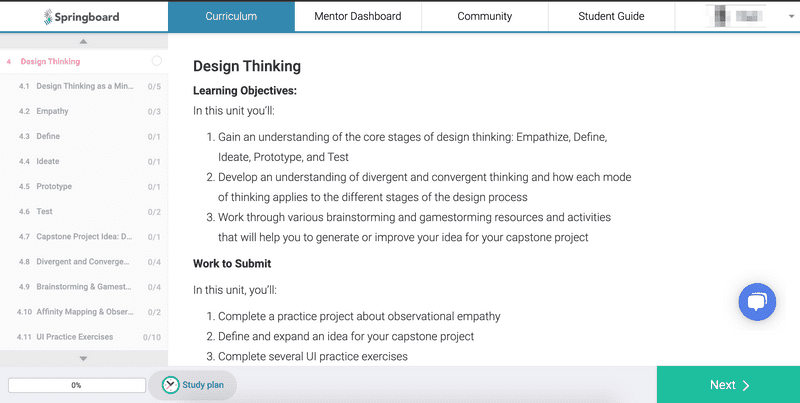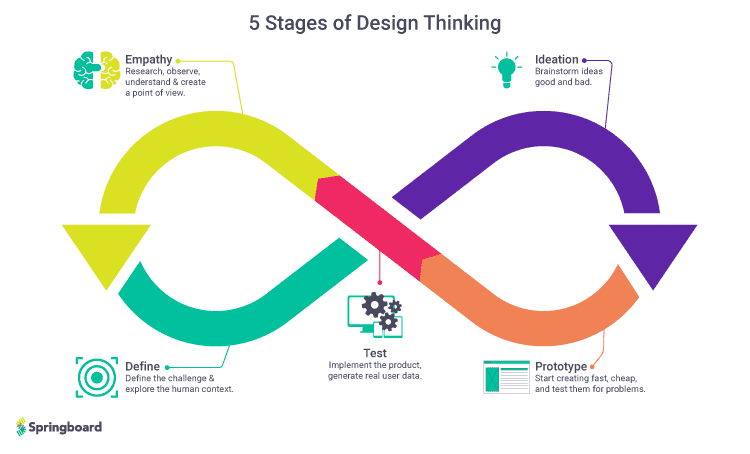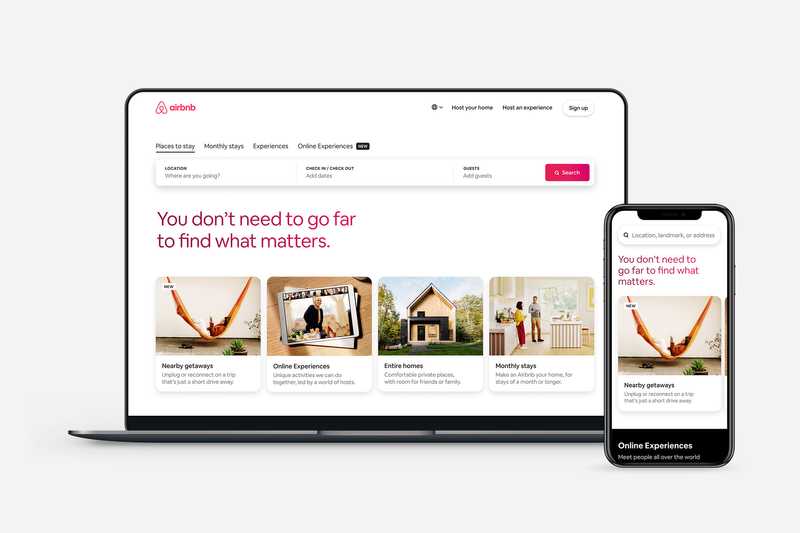What Is Design Thinking?

In this article
- What Is Design Thinking?
- Why Is Design Thinking Important?
- How Do You Learn Design Thinking?
- What Are the 5 Stages of Design Thinking?
- What Are the Key Design Thinking Tools?
- What Are Design Thinking Best Practices?
- How Springboard Can Help You Master Design Thinking
- Success Story: How Airbnb Used Design Thinking To Grow Its Business
Design thinking is a five-stage methodology that fuels outside-the-box thinking and manifests creative solutions to user problems. Its human-centric approach provides UI/UX designers with a range of user-specific goals and offers businesses the chance to innovate and improve customer satisfaction and retention.
The design thinking process is broken up into five specific design thinking stages: empathy, definition, ideation, prototyping, and testing.
What Is Design Thinking?
For most designers, envisioning the end result of a large project—the development of a new product, the construction of a building, or the engineering of a new machine—is thrilling. But the journey to get there is often less so. This is where design thinking can help.
Design thinking lays the foundation of structural and iterative practices used to refine, test, and evolve new ideas.
Why Is Design Thinking Important?
Design thinking is critical for business because it focuses on solutions, not problems. The creative and critical thinking skills of design thinking have proven to be a repeatable problem solving protocol that allows businesses to achieve greater results.
The ultimate goal of design thinking is to design user-friendly products and services. Design thinking allows designers to blueprint solutions to unique user challenges and constantly innovate while doing so.
How Do You Learn Design Thinking?
It’s nearly impossible to work in modern UX or UI design without utilizing the basics of design thinking. Many education tracks, career paths, online bootcamps, and design degrees emphasize a strong core understanding of design thinking early in their curriculums. Design thinking workshops and design thinking training now make up part of every robust design curriculum.
It’s important to note that design thinking is not a replacement for UI/UX design. Rather, design thinking is a philosophical means of solving problems, while user experience is the overall end goal of the effort.
In order to learn design thinking, you must possess a solid foundation in UI/UX design, and a key number of essential skills, including:
- UX research skills
- Wireframing and prototyping skills
- Visual communication skills
- Interaction design skills
- Coding skills
- Analytical skills
- Information architecture skills
Click here to learn more about all the key skills required to become a UI/UX designer.
Design thinking courses and bootcamps will help you gain a more advanced of the design thinking methodology, and usually cover things like:
- The core stages of design thinking
- Divergent and convergent thinking
- Capstone projects
- Applying design thinking to user problems in order to generate user-centric solutions
For example, Springboard’s UI/UX Design Career Track has a dedicated module that covers more than 17 hours of material on design thinking.

Related Read: What Does a UX Designer Do?
What Are the 5 Stages of Design Thinking?
As with any good methodology, design thinking has an iterative and non-linear routine. Design thinking encompasses five different stages that encourage creators to examine different problems and assumptions from a variety of untested angles.
There are five stages of design thinking:
- Empathy
- Definition
- Ideation
- Prototyping
- Testing
Learn more about the five stages of design thinking here.

What Are the Key Design Thinking Tools?
Tools like Typeform, Sketch, and HotJar are all popular platforms that designers lean into to track progress throughout design thinking. For more design-centric tooling, design thinkers lean into popular wire-framing platforms such as InVisionApp or Figma to sketch ideas and iterate frequently as they learn.
Learn more about design thinking tools here.
Get To Know Other Design Students
Florence Chan
Product Designer at Zola
Kashif Ross
UX Analyst at Circulo
Sharon Yeun Kim
UX Design Intern at Colgate-Palmolive
What Are Design Thinking Best Practices?
Design thinking best practices encompass a few major points.
- Empathy and collaboration are at the forefront of maintaining a human-centered approach, both within teams and through to creating an ideal user experience
- Design-led companies like McKinsey integrate design thinking throughout their internal operations and emphasize processes like prototyping and gathering metrics
- Finally, iteration is also key: a fundamental strategy behind design thinking’s success is the openness to new ideas and changes
Learn more about design thinking best practices here.
How Springboard Can Help You Master Design Thinking
Springboard can help you walk away with a comprehensive understanding of every stage in the design thinking processes, including competitive research, user research, and usability testing.
Springboard’s comprehensive design courses require you to apply design thinking skills in real-time during portfolio and industry projects. You will also learn several tools frequently used across all corners of design thinking, including Sketch, Adobe XD, and Figma.
Springboard’s Introduction to Design course allows you to experience the Springboard curriculum in a bite-sized, easily digestible format in four-weeks-time. For aspiring designers who are either curious about new technical skills or want to see if a career in design is a good fit, the design thinking course offers basic design concepts. You will learn how to:
- Conduct research
- Create a user persona
- Sketch possible solutions
- Create low-fidelity wireframes using Sketch or Figma
- Build high-fidelity designs using Sketch or Figma
- Choose to conduct usability tests
For those ready to jump into a more intensive design learning experience, Springboard’s UI/UX Design Career Track teaches more in-depth design concepts. You will learn:
- An empathetic and innovative approach to design-forward thinking that influences your ideation methods while sketching and wireframing
- UI design, heuristics, and interaction design principles through UI practice exercises that let you practice visual elements such as balance, scale, alignment, hierarchy, and others
- How to conduct, synthesize, and present user research in a compelling way to developers and stakeholders
Success Story: How Airbnb Used Design Thinking To Grow Its Business
The travel company Airbnb is a good example of continuous design thinking. Initially seeded as a Y-Combinator company in 2008, Airbnb was struggling after a lackluster launch in 2009. Rather than doubling down and leaning into their assumptions around building a scalable homestay business, Airbnb’s founders instead leaned in another direction after they noticed that almost all online homestay listings featured poor-quality photographs.

This was a human experience problem. Airbnb’s first customers couldn’t afford, didn’t own, or know how to utilize high-end cameras to spice up their listings. To remedy this, Airbnb’s founders rented a camera, traveled to the various homes available for rent, and upgraded every available listing’s photographs themselves. While this obviously wasn’t scalable, it worked as a short-term solution. In less than a month, Airbnb had not only doubled its revenue but had also effectively adopted empathetic design thinking as a core part of its culture.
Need to know more about the essentials of UI/UX design? Visit our comprehensive guide on how to become a UI/UX designer here. Learn how UI/UX designers use design thinking to solve user-focused problems and discover how to acquire key design thinking skills.
Since you’re here…
Are you a future UX designer? Enroll in our UI/UX Bootcamp and join over 10,000 students who have successfully changed careers with us. Want to get wireframing right this second? Check out our free UX learning path today.





